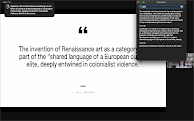Event #3: LASER: De-colonizing AI

A few days ago, I attend the "LASER: De-colonizing AI" in which I learned about different areas of study relating to AI, art, and history that I never have considered. Broadly, the event touched on how AI has introduced new cultural and conceptual frames and ways of thinking. For example, interactive AI has helped minority women share recipes and cooking skills while shaping newly acquired English abilities. This stemmed from AI research students who took the time to design algorithms for teaching cooking. This example made me think more intensely about how AI is quickly integrating itself into our communities, and serving as a problem solver for it. Another project was created for the purpose of serving disabled children. Unemployed artists, teachers, psychologists, designers, and health workers were recruited to create interactive AI systems to help these children communicate. AI has also been found to create problem-solving tools for people who are hard of hearing and vis...




